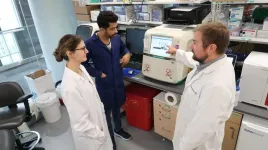(Press-News.org) Rehearsing alternative outcomes of discarding through imagery rescripting shows promise as a treatment strategy for people who hoard, a study by UNSW psychology researchers has shown.
Hoarding disorder is a highly debilitating condition that worsens with age. People who hoard form intense emotional attachments to objects, accumulate excessive clutter, and have difficulty discarding possessions. Many avoid treatment.
People who hoard also experience more frequent, intrusive and distressing mental images in their daily lives, says Mr Isaac Sabel from the Grisham Research Lab, an experimental clinical psychology research group at UNSW Sydney.
“Negative memories and feared outcomes, such as an item rotting in landfill, catastrophic regret or the disappointment of a loved one, can induce anxiety and block the discarding process. Our best evidence-based treatments aren’t getting the outcomes we’d like,” says the psychologist and PhD candidate at UNSW.
“While one in three people who hoard may experience symptom improvement, less than a third of people experience clinically meaningful change. Additionally, there are high rates of dropout and treatment refusal.”
Imagery rescripting is an experiential technique, often used in cognitive behavioural therapy (CBT), where participants introduce positive or benign information to ‘rescript’ the outcomes of negative mental imagery, in this instance worst-case scenarios of discarding.
“It’s typically used to reduce distress associated with negative memories, however, it’s had success with other disorders characterised by future-focused mental imagery, such as generalised anxiety and obsessive-compulsive disorder (OCD),” Mr Sabel says.
This study in 176 people aimed to determine whether rescripting a negative future-focused narrative of discarding helped people with high hoarding traits discard. Participants took part in an online intervention using an item they’d had difficulty discarding. They wrote down their imagined outcome of throwing it away and then completed an exercise based on one of four treatments.
The response to imagery rescripting was compared with cognitive restructuring (learning to identify and disregard irrational, harmful thoughts); imaginal exposure (engaging with anxiety-provoking images/narratives to reduce their impact over time); and dwelling on positive mental imagery to improve their mood (as a control). Participants were then asked to discard their item.
The study found that participants who engaged in imagery rescripting were happier, more motivated and more likely to discard their items. Imagery rescripting was also more effective at reducing anxiety, sadness and anger and increasing feelings of happiness and relaxation around discarding, relative to imaginal exposure and cognitive restructuring.
A participant’s ability to visualise impacted how well imagery rescripting worked, the study found. Rescripting participants completed the Vividness of Visual Imagery Questionnaire (VVIQ), self-rating the vividness of elements within prescribed scenarios, such as a rising sun or a rainbow. Higher creative visualisation abilities were associated with greater readiness and motivation to discard.
These results have been replicated in a second therapist-led study, yet to be published, that compares imagery rescripting with thought listing, a technique found to be effective in facilitating discarding in people with hoarding problems.
Preliminary findings show rescripting outperformed thought listing in key areas, with participants more motivated to discard and more positive about the discarding experience. These findings will now be tested in a clinical trial.
The high costs and treatment challenges of hoarding
Hoarding disorder affects 2.5 per cent of the working-age population, around 715,000 Australians. People who hoard often have a very poor quality of life. The associated psychological distress and social impairment are considered equivalent to living with schizophrenia.
The condition can lead to unsanitary and unsafe living conditions, social isolation, health problems and the inability to work. Hoarding can also contribute to fire, housing, pestilence, falling and other hazards. The cost of returning homes to a liveable state is estimated at more than $87K per hoarding household.
Clutter can make it hard to do things most of us take for granted, such as eating at the table or sleeping in bed, says Professor Jessica Grisham who leads the Grisham Research Lab.
“In the gravest cases, homes are completely unsanitary, either because it has become impossible to clean or because the person saves garbage. The strain on families can be extreme.”
Associated stigma can prevent people who hoard and their families from seeking support. Often hoarding is not addressed until the condition is well established. Additionally, people who hoard have difficulty regulating and tolerating negative emotions, which may reduce engagement with and increase dropout rates from exposure therapy, she says.
“There's so much pressure and often interpersonal conflict for people to get rid of things, hoarding clients can feel quite badgered. They may or may not have a lot of motivation or insight and they feel really stressed and reactive,” she says.
“In this preliminary study, imagery rescripting seems to reduce some of that reactivity. Rather than a direct approach – [asking] what's keeping you from throwing this away … and exploring and challenging those beliefs – it has more of a creative, emotional style that has a lot of potential for hoarding clients.”
Anecdotal evidence suggests people who hoard may have greater creative tendencies. “We know that imagery acts as emotional amplifier. It enables us to access people's emotions, [and engage with] the neural features responsible for processing memories and emotions within the brain,” she says.
“Imagery rescripting emphasises sensory-rich details to create an emotionally evocative and immersive experience. And we think that's in part responsible for the results we've seen.”
The study’s ultra-brief online delivery also has potential as a part of treatment in rural and remote areas where access is an issue and as an early intervention, she says.
Why do people hoard?
Collecting excessive amounts of objects, many worthless by objective standards, may seem difficult to understand, says Prof. Grisham. “However, most of us become attached to at least a few possessions. Perhaps we love the way they look, or they trigger fond memories. Hoarding involves this same type of object attachment, as well over-reliance on possessions and difficulty being away from them.”
While research has shown genetics play a part, hoarding is more likely caused by a range of psychological, neurobiological and social factors. Hoarding disorder has been linked to early trauma, life stress and emotional deprivation.
“People who hoard often report excessively cold parenting, difficulty connecting with others, and traumatic childhood experiences. They may end up believing people are unreliable and untrustworthy, and that it’s better to rely on objects for comfort and safety,” she says.
Their experiences have taught them their self-identity is tangled up in what they own; that if they part with their possessions, they will lose themselves, she says.
Hoarding disorder is also associated with high rates of attention deficit and hyperactivity disorder. Difficulties with planning, decision-making and categorising can make it hard to organise and discard possessions, says Prof. Grisham. “The person ends up avoiding these tasks, which leads to unmanageable levels of clutter.”
Imagery rescripting is particularly exciting because of its potential to address both the foundational traumas that inform our future-focused narratives – an area of research interest for the lab – as well as tackling intrusive distressing mental images that interfere with discarding in the present, she says.
“Images can link our past, present and future. Rescripting memories that may have triggered hoarding – going back and meeting those needs – may open up the doorway for greater treatment outcomes and greater positive impact on clients’ lives.”
END
Hoarding disorder: ‘sensory CBT’ treatment strategy shows promise
A novel treatment strategy for hoarding disorder has demonstrated its potential in a pre-clinical study.
2024-10-04
ELSE PRESS RELEASES FROM THIS DATE:
Water fluoridation less effective now than in past
2024-10-04
The dental health benefits of adding fluoride to drinking water may be smaller now than before fluoride toothpaste was widely available, an updated Cochrane review has found.
The team of researchers from the Universities of Manchester, Dundee and Aberdeen reviewed the evidence from 157 studies which compared communities that had fluoride added to their water supplies with communities that had no additional fluoride in their water. They found that the benefit of fluoridation has declined since the 1970s, when fluoride toothpaste became more widely available.
The contemporary studies were conducted in high-income countries. The impact of community water fluoridation ...
Toddlers get nearly half their calories from ultra-processed foods
2024-10-04
Toddlers in the UK obtain nearly half (47%) of their calories from ultra-processed foods (UPFs), and this rises to 59% by the age of seven, according to a new study led by UCL researchers.
The study, published in the European Journal of Nutrition, looked at data from 2,591 children born in the UK in 2007 and 2008 whose parents recorded what their children ate and drank over three days.
The most common UPFs consumed by the toddlers – who were 21 months when their parents recorded their diets – were flavoured ...
Detroit researchers to examine links between bacterial infections, environmental pollution and preterm birth
2024-10-03
DETROIT — A new grant will help Wayne State University researchers explore the links between bacterial infections, the environmental factors that increase their susceptibility and the risk of preterm birth.
The five-year, $2,858,821 grant from the National Institute of Environmental Health Sciences of the National Institutes of Health, “PFAS increases susceptibility to infection-mediated preterm birth,” will be led by Michael Petriello, Ph.D., assistant professor in Wayne State’s Institute of Environmental Health Sciences and Pharmacology in the School of Medicine.
Petriello hopes that the team’s studies will identify critical pathways responsible ...
In lab tests, dietary zinc inhibits AMR gene transmission
2024-10-03
Highlights:
Antimicrobial resistance is a growing threat.
Bacteria exchange AMR genes in the gut via circular genetic material called plasmids.
In lab experiments, bacteria transferred plasmids with AMR genes in the presence of zinc at reduced or nonexistent rates.
Stopping the transfer without killing microbes may help reduce AMR without disrupting the gut microbiome.
Washington, D.C.—Genes responsible for antimicrobial resistance (AMR) can spread from microbe to microbe through circular genetic material called plasmids, and ...
Two UMD Astronomy space probes advance to next round of $1 billion NASA mission selection
2024-10-03
On October 3, 2024, NASA announced that two space probes proposed by University of Maryland astronomers have advanced to the next round of consideration for a $1 billion mission slated to launch into orbit in 2032.
The selected probes include the Advanced X-ray Imaging Satellite (AXIS) mission with UMD Astronomy Professor Christopher Reynolds as its principal investigator and the PRobe far-Infrared Mission for Astrophysics (PRIMA) with UMD Astronomy Professor Alberto Bolatto as a co-investigator and NASA Goddard Space Flight Center researcher and UMD Astronomy ...
New MSU research sheds light on impact and bias of voter purging in Michigan
2024-10-03
MSU has a satellite uplink/LTN TV studio and Comrex line for radio interviews upon request.
Images and Podcast
EAST LANSING, Mich. – In recent years, some states have prioritized purging their voter rolls of those who have passed away or moved out of state. During election season, there is often increased discussion about the necessity and impact of these actions. Voter purging can be an important step for creating election integrity, but others have raised concerns about how the process is conducted and who it targets.
So, are there negative effects of voter purging? Researchers from Michigan State University wanted to find out — especially ...
Funding to create world's first ovarian cancer prevention vaccine
2024-10-03
In this study, the Cancer Research UK-funded scientists will establish the targets for the vaccine. They will find out which proteins on the surface of early-stage ovarian cancer cells are most strongly recognised by the immune system and how effectively the vaccine kills mini-models of ovarian cancer called organoids.
If this research is successful, work will then begin on clinical trials of the vaccine. The hope is that in the future, women could be offered this vaccine to prevent ovarian cancer in the first place.
There are around 7,500 new ovarian ...
Scientists develop novel method for strengthening PVC products
2024-10-03
COLUMBUS, Ohio – Researchers have developed a way to make one type of plastic material more durable and less likely to shed dangerous microplastics.
The study identified a secure way to attach chemical additives to polyvinyl chloride (PVC).
Found in everything from toys, construction supplies and medical packaging, PVC plastics currently rank third among the most used plastics worldwide. Despite its widespread use, pure PVC is brittle and sensitive to heat, and manufacturers can only utilize it after stabilizing its properties with other chemicals.
However, these additives, or plasticizers, ...
Houston Methodist part of national consortium to develop vaccine against herpesviruses
2024-10-03
Houston Methodist researchers will be part of a national consortium funded by an up to $49 million award from the U.S. Government’s Advanced Research Projects Agency for Health (ARPA-H) to develop a vaccine against two of the most common and destructive strains of herpesviruses that latently infect a majority of Americans and can lead to acute infections, multiple forms of cancer, autoimmune disease and birth defects.
The award is part of ARPA-H’s Antigens Predicted for Broad Viral Efficacy through Computational Experimentation (APECx) program and will fund the America’s SHIELD project ...
UT Health San Antonio School of Dentistry earns first NIH grant under new center for pain therapeutics and addiction research
2024-10-03
SAN ANTONIO, Oct. 3, 2024 – The School of Dentistry at The University of Texas Health Science Center at San Antonio (UT Health San Antonio) earned the first National Institutes of Health grant under its new Center for Pain Therapeutics and Addiction Research, addressing pain in patients with head and neck carcinoma.
The nearly $600,000 grant by the NIH’s National Institute of Dental and Craniofacial Research will address this critical pain issue that significantly impairs quality of life. Many head and neck carcinoma patients require opiate pain management, but tolerance develops quickly, requiring new pain ...
LAST 30 PRESS RELEASES:
Neuroscientists devise formulas to measure multilingualism
New prostate cancer trial seeks to reduce toxicity without sacrificing efficacy
Geometry shapes life
A CRISPR screen reveals many previously unrecognized genes required for brain development and a new neurodevelopmental disorder
Hot flush treatment has anti-breast cancer activity, study finds
Securing AI systems against growing cybersecurity threats
Longest observation of an active solar region
Why nail-biting, procrastination and other self-sabotaging behaviors are rooted in survival instincts
Regional variations in mechanical properties of porcine leptomeninges
Artificial empathy in therapy and healthcare: advancements in interpersonal interaction technologies
Why some brains switch gears more efficiently than others
UVA’s Jundong Li wins ICDM’S 2025 Tao Li Award for data mining, machine learning
UVA’s low-power, high-performance computer power player Mircea Stan earns National Academy of Inventors fellowship
Not playing by the rules: USU researcher explores filamentous algae dynamics in rivers
Do our body clocks influence our risk of dementia?
Anthropologists offer new evidence of bipedalism in long-debated fossil discovery
Safer receipt paper from wood
Dosage-sensitive genes suggest no whole-genome duplications in ancestral angiosperm
First ancient human herpesvirus genomes document their deep history with humans
Why Some Bacteria Survive Antibiotics and How to Stop Them - New study reveals that bacteria can survive antibiotic treatment through two fundamentally different “shutdown modes”
UCLA study links scar healing to dangerous placenta condition
CHANGE-seq-BE finds off-target changes in the genome from base editors
The Journal of Nuclear Medicine Ahead-of-Print Tip Sheet: January 2, 2026
Delayed or absent first dose of measles, mumps, and rubella vaccination
Trends in US preterm birth rates by household income and race and ethnicity
Study identifies potential biomarker linked to progression and brain inflammation in multiple sclerosis
Many mothers in Norway do not show up for postnatal check-ups
Researchers want to find out why quick clay is so unstable
Superradiant spins show teamwork at the quantum scale
Cleveland Clinic Research links tumor bacteria to immunotherapy resistance in head and neck cancer
[Press-News.org] Hoarding disorder: ‘sensory CBT’ treatment strategy shows promiseA novel treatment strategy for hoarding disorder has demonstrated its potential in a pre-clinical study.


